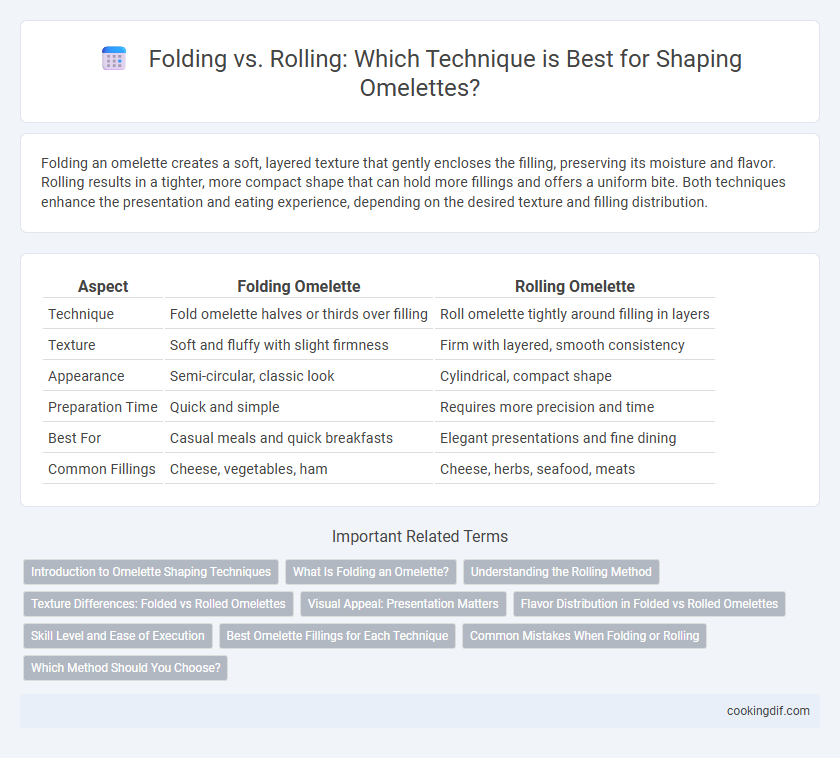Folding an omelette creates a soft, layered texture that gently encloses the filling, preserving its moisture and flavor. Rolling results in a tighter, more compact shape that can hold more fillings and offers a uniform bite. Both techniques enhance the presentation and eating experience, depending on the desired texture and filling distribution.
Table of Comparison
| Aspect | Folding Omelette | Rolling Omelette |
|---|---|---|
| Technique | Fold omelette halves or thirds over filling | Roll omelette tightly around filling in layers |
| Texture | Soft and fluffy with slight firmness | Firm with layered, smooth consistency |
| Appearance | Semi-circular, classic look | Cylindrical, compact shape |
| Preparation Time | Quick and simple | Requires more precision and time |
| Best For | Casual meals and quick breakfasts | Elegant presentations and fine dining |
| Common Fillings | Cheese, vegetables, ham | Cheese, herbs, seafood, meats |
Introduction to Omelette Shaping Techniques
Folding and rolling are two fundamental omelette shaping techniques that influence texture and presentation, with folding creating a soft, layered interior and rolling producing a compact, cylindrical form ideal for fillings. Mastery of folding often involves gently lifting and folding the omelette in half or thirds, preserving airiness, while rolling requires precise control to evenly cook and encase ingredients. These methods significantly impact the classic French omelette's delicate structure and the more robust Japanese tamagoyaki, illustrating the diverse culinary applications of omelette shaping.
What Is Folding an Omelette?
Folding an omelette involves gently lifting one edge and folding it over the filling to create a half-moon shape, preserving the omelette's tender texture and ensuring even cooking. This technique maintains a soft, slightly runny interior while enclosing ingredients like cheese, vegetables, or meats. Folding contrasts with rolling by creating a thicker, more delicate omelette rather than a tightly wrapped cylindrical shape.
Understanding the Rolling Method
The rolling method for shaping an omelette involves carefully lifting one edge and gently rolling it over the filling to form a tight, cylindrical shape that enhances presentation and texture. This technique helps evenly distribute the ingredients and retains moisture, resulting in a fluffy, tender omelette. Mastering the rolling method requires precise timing and a non-stick pan to prevent sticking and ensure a smooth, uniform roll.
Texture Differences: Folded vs Rolled Omelettes
Folded omelettes feature a soft, fluffy texture achieved by gently cooking eggs and folding them once or twice, preserving airiness and a tender bite. Rolled omelettes, often prepared with thin layers of egg cooked and rolled tightly, result in a denser, slightly firmer texture with a layered structure. The choice between folding and rolling affects moisture retention and mouthfeel, making folded omelettes lighter while rolled versions offer a more compact, uniform consistency.
Visual Appeal: Presentation Matters
Folding an omelette creates a classic, smooth half-moon shape that showcases a clean, elegant presentation ideal for fine dining. Rolling an omelette results in a cylindrical, layered appearance that highlights texture and vibrancy, often favored in Japanese Tamagoyaki or French techniques. Both methods enhance visual appeal by emphasizing structure and filling distribution, influencing the dish's overall attractiveness on the plate.
Flavor Distribution in Folded vs Rolled Omelettes
Folding an omelette creates distinct layers that allow fillings to remain more concentrated, intensifying flavor bursts in each bite. Rolled omelettes evenly distribute ingredients throughout, producing a consistent taste but slightly diluting individual flavor intensity. The choice between folding and rolling affects the texture and the way flavors meld, making each method ideal for different taste preferences.
Skill Level and Ease of Execution
Folding an omelette requires moderate skill to gently lift and fold the cooked egg without tearing, offering a classic crescent shape that is visually appealing and easy to master for beginners. Rolling an omelette demands higher dexterity and precision to create a uniform, tubular form, often favored by experienced cooks for its elegant presentation and consistent texture. Both techniques influence ease of execution, with folding being more forgiving while rolling enhances control and refinement in omelette preparation.
Best Omelette Fillings for Each Technique
Folding an omelette creates soft, layered pockets ideal for delicate fillings like spinach, mushrooms, and goat cheese, enhancing texture without overwhelming the egg. Rolling suits heartier ingredients such as ham, cheddar, and bell peppers, distributing flavors evenly throughout the cylindrical shape. Selecting fillings based on omelette shaping techniques ensures balanced taste and optimal presentation for every meal.
Common Mistakes When Folding or Rolling
Common mistakes when folding or rolling an omelette include applying too much pressure, which causes the eggs to tear or break, and starting the fold or roll too early before the eggs are fully set, resulting in a runny interior. Using a spatula that's not properly greased or too large can disturb the delicate texture and cause sticking. Inconsistent heat control often leads to uneven cooking, making precise folding or rolling difficult and affecting the omelette's final shape and texture.
Which Method Should You Choose?
Folding an omelette creates a classic, tender texture that gently encloses fillings while maintaining a soft interior, ideal for delicate ingredients like cheese and herbs. Rolling an omelette results in a tighter, cylindrical shape that offers a firmer bite and allows for denser fillings such as vegetables or meats, making it perfect for hearty meals like a Japanese tamagoyaki. Choose folding for a light, airy experience and rolling for a structured, filling-rich omelette.
Folding vs Rolling for shaping Infographic

 cookingdif.com
cookingdif.com